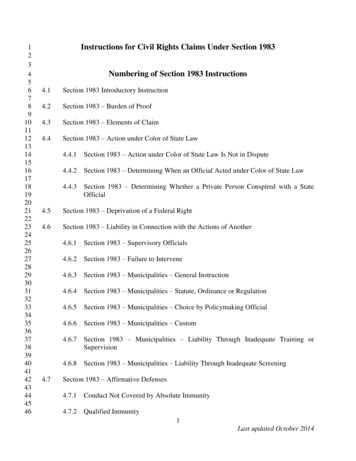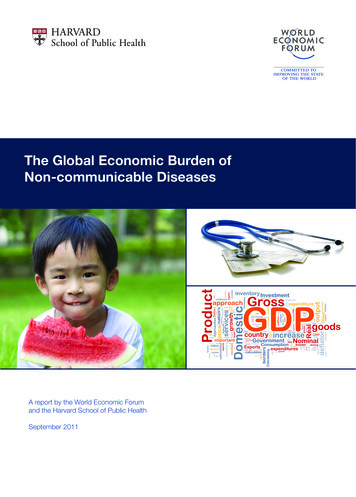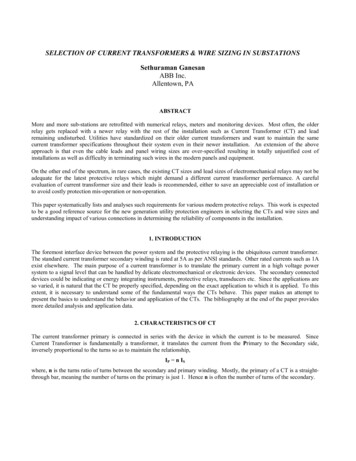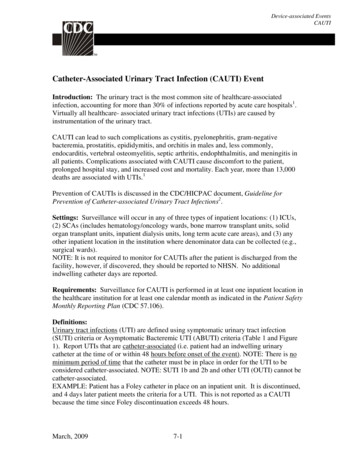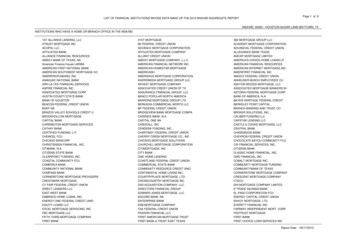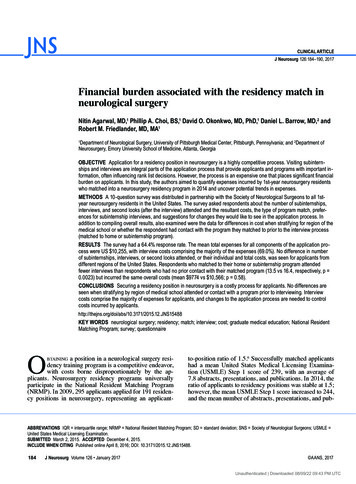
Transcription
clinical articleJ Neurosurg 126:184–190, 2017Financial burden associated with the residency match inneurological surgeryNitin Agarwal, MD,1 Phillip A. Choi, BS,1 David O. Okonkwo, MD, PhD,1 Daniel L. Barrow, MD,2 andRobert M. Friedlander, MD, MA1Department of Neurological Surgery, University of Pittsburgh Medical Center, Pittsburgh, Pennsylvania; and 2Department ofNeurosurgery, Emory University School of Medicine, Atlanta, Georgia1Objective Application for a residency position in neurosurgery is a highly competitive process. Visiting subinternships and interviews are integral parts of the application process that provide applicants and programs with important information, often influencing rank list decisions. However, the process is an expensive one that places significant financialburden on applicants. In this study, the authors aimed to quantify expenses incurred by 1st-year neurosurgery residentswho matched into a neurosurgery residency program in 2014 and uncover potential trends in expenses.Methods A 10-question survey was distributed in partnership with the Society of Neurological Surgeons to all 1styear neurosurgery residents in the United States. The survey asked respondents about the number of subinternships,interviews, and second looks (after the interview) attended and the resultant costs, the type of program match, preferences for subinternship interviews, and suggestions for changes they would like to see in the application process. Inaddition to compiling overall results, also examined were the data for differences in cost when stratifying for region of themedical school or whether the respondent had contact with the program they matched to prior to the interview process(matched to home or subinternship program).Results The survey had a 64.4% response rate. The mean total expenses for all components of the application process were US 10,255, with interview costs comprising the majority of the expenses (69.0%). No difference in numberof subinternships, interviews, or second looks attended, or their individual and total costs, was seen for applicants fromdifferent regions of the United States. Respondents who matched to their home or subinternship program attendedfewer interviews than respondents who had no prior contact with their matched program (13.5 vs 16.4, respectively, p 0.0023) but incurred the same overall costs (mean 9774 vs 10,566; p 0.58).Conclusions Securing a residency position in neurosurgery is a costly process for applicants. No differences areseen when stratifying by region of medical school attended or contact with a program prior to interviewing. Interviewcosts comprise the majority of expenses for applicants, and changes to the application process are needed to controlcosts incurred by 12.JNS15488Key Words neurological surgery; residency; match; interview; cost; graduate medical education; National ResidentMatching Program; survey; questionnaireObtaining a position in a neurological surgery residency training program is a competitive endeavor,with costs borne disproportionately by the applicants. Neurosurgery residency programs universallyparticipate in the National Resident Matching Program(NRMP). In 2009, 295 applicants applied for 191 residency positions in neurosurgery, representing an applicant-to-position ratio of 1.5.6 Successfully matched applicantshad a mean United States Medical Licensing Examination (USMLE) Step 1 score of 239, with an average of7.8 abstracts, presentations, and publications. In 2014, theratio of applicants to residency positions was stable at 1.5;however, the mean USMLE Step 1 score increased to 244,and the mean number of abstracts, presentations, and pub-Abbreviations IQR interquartile range; NRMP National Resident Matching Program; SD standard deviation; SNS Society of Neurological Surgeons; USMLE United States Medical Licensing Examination.SUBMITTED March 2, 2015. ACCEPTED December 4, 2015.include when citing Published online April 8, 2016; DOI: 10.3171/2015.12.JNS15488.184J Neurosurg Volume 126 January 2017 AANS, 2017Unauthenticated Downloaded 08/09/22 09:43 PM UTC
Financial burden for neurosurgery residency matchlications increased to 11.7.7 Unfortunately, in addition tobeing competitive, applying for a neurosurgical residencyposition is also an expensive process.The high costs of applying to a neurosurgical residencyare largely due to the informal requirement of subinternships as a visiting student and the large number of interviews typically attended. Subinternships and in-personinterviews at each program are important components ofthe neurosurgery match. Subinternships give students anopportunity to learn more about the many facets of programs they may potentially be interested in. Students gaininsight into alternative approaches to pathologies that maydiffer from those of their home institution as well as learnmore about the culture of the program, the residents andfaculty, and the city. Subinternships also act as an indicator to programs of a student’s serious exploration of andcommitment to the field, and offer an opportunity to evaluate students with much more depth than can usually bedone in 1 or 2 days of interviewing. In-person interviewsare important to both students and programs because theygive parties an opportunity to get to know the places andpeople they might work with for the next 7 years, whichcan have major influence on a student’s career.However, all of the benefits of subinternships and inperson interviewing come at a significant cost to applicants. For subinternships, applicants must travel to a program and bear the costs of housing and transportation fora month. Many students do multiple subinternships. Dueto the relatively small number of neurosurgery residencyprograms (102 in the 2014 match), small number of positions at each program (206 positions initially planned forthe 2014 match), and overall competitiveness of the applicant pool, applicants typically apply to a wide geographicrange of programs.8 The costs of travel and lodging for interviews can be significant, especially when multiple tripsare made to the same region of the country since programsdo not coordinate their interview schedules. These costsare particularly relevant to neurosurgery and a handful ofother competitive surgical specialties with limited residency programs, such as orthopedic surgery, otolaryngology, and plastic surgery.The goal of this study was to determine the costs toapplicants of applying for a neurosurgical residency position and gain direct feedback regarding practical potentialsteps that could be taken to reduce costs. We sought toexamine how various applicant-based factors may influence the financial burden of applying for a neurosurgicalresidency.MethodsIn partnership with the Society of Neurological Surgeons (SNS), a 10-item survey was sent in early November2014 to the chairmen and program coordinators at everyneurosurgical residency program in the United States topass on to their 1st-year residents who matched in the 2014NRMP. The survey included both fill-in-the-blank andmultiple-choice questions regarding the number of subinternships completed, interviews attended, and secondlooks attended after the interview, the cost of traveling foreach of these events, whether the applicant had exposureto the residency program prior to interviewing, and preferences for interviewing during a subinternship (Table 1).A free-response section at the end of the survey asked forcomments or suggestions regarding interviewing.Normality of variables was assessed using the Kolmogorov-Smirnov test. Normally distributed continuousvariables are presented as means and standard deviations(SDs). Medical schools were ranked and categorized intoquartiles using the U.S. News & World Report’s BestMedical Schools: Research Rankings.12 Tests of statisticalsignificance include 2-tailed t-test dichotomous comparisons and analysis of variance for greater than 2 groups.Non-normal distribution of continuous variables is presented as medians and interquartile ranges (IQRs) (25th to75th percentile), and tests of statistical significance includeTABLE 1. Summary of survey responses received from 130current postgraduate 1st-year neurosurgery residentsItemAttended medical school with residencyprogram, %No. of subinternships completed, median (IQR)No. of interviews attended, mean SDNo. of second looks attended, median (IQR)CostSubinternshipsMean SDMedianIQR% of total expenseInterviewsMean SDMedianIQR% of total expenseSecond looksMean SDMedianIQR% of total expenseTotalMean SDMedianIQRMatched into, %HomeSubinternshipSecond lookOther programNo responsePreference for subinternship interviews, %During subinternshipDuring formal interview processNo responseValue75.43 (2–3)15.3 5.41 (0–2) 2840 2360 2100 1500–300028.3 7180 3880 7000 4500–10,00069.0 293 450 50 0–5002.8 10,300 5170 10,000 6500–13,00017.721.513.936.910.033.150.016.9J Neurosurg Volume 126 January 2017185Unauthenticated Downloaded 08/09/22 09:43 PM UTC
N. Agarwal et al.the Wilcoxon rank-sum test for dichotomous comparisonsand the Kruskal-Wallis test for greater than 2 groups. Posthoc paired comparisons were adjusted for using the conservative Bonferroni correction. For categorical variables,frequencies and percentages are reported, and statisticalsignificance was calculated using the Fisher exact test orchi-square test. Correlation between 2 variables was measured using Pearson correlation coefficient. Results wereconsidered statistically significant for p values less than0.05. Statistical analyses were conducting using Stata 13(StataCorp), and maps of respondent location were generated using R 3.1.1 and the ggplot2 package.ResultsResponses were received from 130 of 202 current postgraduate 1st-year neurosurgery residents, corresponding toa 64.4% response rate. The distribution of the respondents’medical schools and residency programs was graphicallydepicted (Supplemental Figs. 1 and 2, respectively). Allrespondents completed the first 8 questions of the survey,which included the name of the medical school, name ofthe residency program, and the number and cost of subinternships, interviews, and second looks attended. A totalof 90.0% of respondents (117 residents) answered the ninthquestion (matched into home, subinternship, second look,or other program), and 83.1% respondents (108 residents)answered the tenth question (subinternship interview preference: during the subinternship or during the formal interview process). Eight respondents added suggestions orcomments regarding the interviewing process.Table 1 summarizes the results for the entire group ofrespondents. Respondents completed a median of 3 sub-internships (IQR 2–3), attended a mean of 15.3 5.4 interviews, and attended a median of 1 second look (IQR0–2). Almost half of the respondents (46.2%) did not attend any second looks. The corresponding mean costsfor subinternships, interviews, and second looks were US 2840 (median 2100, IQR 1500– 3000); 7180 (median 7000, IQR 4500– 10,000); and 293 (median 50, IQR 0– 500), respectively. The mean total cost of the entireapplication process was 10,300 (median 10,000; IQR 6500– 13,000), with interview expenses comprising thelargest proportion (69.0%), followed in descending costby subinternships (28.3%) and then second looks (2.8%).Some 17.7% of respondents matched their home program,21.5% matched a subinternship site, 13.9% matched aprogram where they attended a second look, and 36.9%matched a program they did not have contact with otherthan the interview (Fig. 1). Half of respondents stated theywould prefer to have interviews for subinternship sitesthrough the formal interview process, while 33.1% statedthey would prefer to complete these interviews during thesubinternship (Fig. 2). A moderate correlation was foundbetween the number of interviews attended and the cost ofinterviews (Pearson correlation coefficient 0.61).Stratifying survey results by whether applicants hadcontact with the program they matched prior to the interview process (home or subinternship) versus those whomatched at programs they did not have contact with priorto the interview process (attended second look or only contact was interview) reveals almost no difference betweenthe 2 groups (Supplemental Table 1). Respondents who hadno prior contact with the program to which they matchedattended more interviews than those who matched theirhome or subinternship program (16.4 vs 13.5 interviewsFig. 1. Pie chart showing the program match type for 117 of 130 respondents who answered this question. Twenty-threerespondents matched into their home program, 28 into subinternships, 18 into second looks, and 48 into other program. Thirteenresidents did not answer this question. Figure is available in color online only.186J Neurosurg Volume 126 January 2017Unauthenticated Downloaded 08/09/22 09:43 PM UTC
Financial burden for neurosurgery residency matchFig. 2. Pie chart showing applicant preferences for the subinternship interviews. Of the 130 respondents, 108 answered this question; 43 respondents preferred interviewing during their subinternship, and 65 preferred interviewing during the formal interviewprocess. Twenty-two residents did not answer this question. Figure is available in color online only.attended, respectively, p 0.0023). However, there was nodifference in interview-related costs for the 2 groups, norwas there any difference in total expenses. No other statistically significant difference was found in the survey itemsof interest.Results of the survey were stratified by the region ofthe respondents’ medical school (Supplemental Table 2).Medical school regions were based on divisions set bythe SNS (https://www.societyns.org/match information.html).12 No differences were observed for responses to anysurvey question across the 6 regions of the United States.Analyses of survey results after ranking and categorizing medical schools by quartiles were conducted (Supplemental Table 3). A statistically significant difference wasdetected in the number of second looks attended. Multiplecomparisons of number of second looks attended revealeda significant difference between the 1st and 4th quartiles(mean 1.55 versus 0.63 second looks attended, respectively, p 0.0162). No significant differences betweenquartiles were detected for number of subinternships orinterviews attended. Likewise, no differences were seenin subinternship, interview, second look, or total expenses.The same pattern is seen when stratifying school rankingby top 10 versus all others (Supplemental Table 4).Figure 3 illustrates the number of second looks attended stratified by type of program match. As previously noted, 46.2% of respondents did not attend a secondlook. There was significant association between type ofprogram match and number of second looks attended (p 0.0001). Respondents who matched into a second lookFig. 3. Bar graph showing the number of second looks attended stratified by program match type. Of the 130 respondents, 23(17.7%) matched into a home program, 28 (21.5%) into a subinternship, 18 (13.9%) into a second look program, and 48 (36.7%) intoother. Thirteen residents (10.0%) did not answer this question. Figure is available in color online only.J Neurosurg Volume 126 January 2017187Unauthenticated Downloaded 08/09/22 09:43 PM UTC
N. Agarwal et al.program attended a mean of 2.33 second looks (SD 1.08),while those who matched at their home, subinternship, orother programs attended an a mean of 0.74 (SD 0.81), 1.1(SD 1.1), and 0.54 (SD 0.80) second looks, respectively.However, the inverse was not true; the number of secondlooks attended was not associated with type of programmatch (p 0.2056). These findings indicate that respondents who matched to a second look program were likelyto have attended more second looks, but attending moresecond looks did not necessarily mean a respondent wouldmatch at a second look program.Several respondents commented on their experienceswhile interviewing as well as had suggestions for howto improve the entire process. Of the 8 respondents whocommented on the survey, 5 suggested that programs inthe same city or same region should coordinate their interviews to fall within the same week without overlap. Tworespondents also noted that the opportunity to arrive earlyor stay an extra day to shadow chief residents allowedthem to integrate a second look with their interview trip,giving them additional insight into the programs while reducing the amount of travel. Two respondents noted thatthey knew very early in the application process that theywished to stay at their home institution. As such, these respondents would have favored an avenue through which tocommunicate their preference and, therefore, reduce theassociated costs of interviewing. Several suggestions (n 3) were made for large-scale changes to the very nature ofthe interview process. A common theme was the adoptionof a centralized interviewing process, involving many applicants and programs in the same location. One potentialaddition to centralized interviewing would be the inclusion of a 2-part matching process, where applicants firstparticipate in centralized interviews, create a rank list,and are then “matched” to a limited number of programs.Applicants could then visit these programs for additionalinterviews and tours, submit a second rank list, and thenbe matched to their final program.DiscussionCost of Applying for Neurosurgery Residency ComparedWith Other Surgical Subspecialties and the Cost ofMedical SchoolWe demonstrate that costs to applicants for neurosurgical residency are high. Our data show that medical students typically attend approximately 2 away rotations, 15interviews, and 1 second look. The mean total expense forall components of the application process was 10,255,(median 10,000; IQR 6500– 13,000). Thus, the bestestimate is that 3.44 million were spent by the 335 applicants who sought neurosurgery positions in the 2014NRMP.After adjusting for inflation, the mean cost to applicants in the interview portion of the neurosurgery matching process ( 7180) is higher than the average cost of interviewing to plastic surgery applicants ( 4698) in 2009,reported by Rogers et al., and in 2013 ( 6262), reported byClairborne et al.2,10 Kerfoot et al. reported that after adjusting for inflation the median cost of the interview processto applicants for urology residencies in 2006 was 4697.3188The increased cost to our cohort is likely explained bythe number of interviews attended; our cohort attended amean of 15.3 interviews while the cohorts of Rogers et al.and Kerfoot et al. attended a mean of 7.0 and median of12 interviews, respectively.3,10 Similarly, a higher proportion of our respondents attended more than 14 interviewscompared with that of the cohort studied by Claiborne etal. (46% vs 35%).2 We found that the cost of interviewing accounted for approximately 65%–70% of total expenses. The Association of American Medical Collegesreports that the average tuition and fees for the 2013–2014academic year were 31,783 for in-state students at publicmedical schools and 52,093 for private medical schools.1These figures do not include the cost of housing, transportation, health insurance, or other living expenses. Thecost of the entire application process clearly represents asignificant financial burden to applicants, in addition totheir existing financial obligations.Predictors of Cost of Applying for a NeurosurgicalResidencyWe were unable to detect any clear pattern associatedwith travel burden or cost of the application process in ouranalyses. Regardless of which region of the country medical students come from, they generally complete the samenumber of subinternships, attend the same number of interviews, and spend the same amount of money. Accordingly, contact with a program prior to the application process (matched to home or subinternship program) led to astatistically significant difference in number of interviewsattended compared with no prior contact (13.5 vs 16.4 interviews attended, respectively), but there was no difference in interview or total expenses. The NRMP reportsin “Charting Outcomes in the Match, 2014” that matchedU.S. senior medical student applicants contiguously rankedan average of 14.9 programs compared with 9.5 for unmatched student.7 This is likely a reflection of the numberof interviews attended, and there may be differences incosts between the 2 groups that we were not able to capturein our survey. Stratifying respondents by medical schoolranking revealed a significant difference between the 1stversus 4th quartiles for number of second looks attendedbut for no other measures. This pattern held true whencomparing the top 10 schools versus all others. Potentialexplanations for the lack of differences across multipletypes of stratifications include applicants applying broadlyacross the country, costs due to travel for interviews thatcannot be grouped with other interviews, and savings fromstaying with friends or family while traveling. Our finding of a moderate correlation between the number of interviews attended and interview expenses is not surprising,and an intuitive solution to reducing costs for applicants isto reduce the number of interviews required to match.Proposals for Reducing the Financial Burden onApplicantsHere we discuss suggestions from our respondents anda subcommittee of the SNS for reducing the costs of interviewing for a neurosurgery residency. The suggestionsrange from relatively minor modifications of the currentJ Neurosurg Volume 126 January 2017Unauthenticated Downloaded 08/09/22 09:43 PM UTC
Financial burden for neurosurgery residency matchsystem to wholesale changes in the way the interview process is conducted.Minor Changes to the Current Interview ProcessThe current interview process does not take into account the pre-interview preferences of applicants andprograms. Several of our respondents expressed frustration with this. Our data demonstrate that approximately40% of medical students match to their home program ora program in which they did a subinternship. Althoughthese students attended fewer interviews than applicantswho went on to match at a program they did not have preinterview contact with, there was no statistical differencein the expenses associated with interviewing or with theentire application process. While we did not survey program directors for their input on the issue of pre-interviewpreferences, it is not difficult to imagine that there maybe certain students from their home institution or subinternships who they know will be highly ranked prior tothe interview process. One potential solution would be toallow students to “pre-match” to their home or subinternship program. Such an arrangement would likely requirelimits on the number of positions available for pre-matchand close monitoring to ensure that students who do notpre-match have a fair opportunity to apply for programs.Clearly, solving the issue of pre-interview preferencewould require important changes to the application process, which would not be trivial to implement but may significantly reduce the financial burden of the applicationprocess for some applicants.Approximately one-third of the residents voiced a preference for interviews to be held during subinternships. Itis unclear to us how prevalent this practice is. However,the adoption of student interviews during subinternshipswould easily reduce the costs of interviewing without requiring significant modifications to the current system.Other relatively easy modifications proposed by a subcommittee of the SNS for reducing the financial burden onapplicants include hard limits on the number of programsfor which an applicant can interview and on the numberof applicants a program can interview; standardization ofthe interview day structure to reduce lodging costs; andthe creation of a centralized database of program characteristics including the number and subspecialty training offaculty, the number and types of cases carried out, hospitalcharacteristics, and residency program structure with regard to rotations, calls, didactics, outcomes for graduatesof the program, etc.Moderate Changes to the Current Interview ProcessThe suggestion to coordinate interview dates accordingto city or region was very popular in our survey. Applicants wished to travel to 1 city or region and complete allof the relevant interviews without being required to returnlater in the interview season. Implementing such a systemcould be achieved at varying scales. One option is for programs in the same city or region to communicate directlywith each other to coordinate interviews for 1 week eachmonth, without overlap between programs. Alternatively,a larger scale effort could be organized so that programsin a particular geographic area would agree to completetheir entire interview season in a set period of time, withcoordinated dates to prevent overlap, or applicants andprograms could be assigned to “rotations,” where a givencohort of students may interview within each region in agiven time frame before moving on to the next one.Major Changes to the Current Interview ProcessSeveral respondents expressed interest in a centralized,in-person interview process to significantly reduce travelrequirements. One paradigm would be to hold centralized interviews only in large hub cities with key facultyand residents. This system would significantly save timeand money for applicants; however, it would deprive themof the opportunity to see the city in which the programis situated, tour the facilities, and meet the residents andfaculty who did not travel for the interviews. A combinedapproach would use the centralized regional interviewsas only a screening mechanism to determine which applicants will receive an interview at the program. In sucha system, the number of interviews for each applicantand the number of applicant invitations for each programwould be limited to prevent hoarding of interviews by exceptional candidates. Applicants would then interview ata limited number of programs with some degree of assurance that they would match.Strengths and LimitationsOur study has several strengths and limitations. Onekey strength is that we conducted the survey in partnershipwith the SNS and confirmed that responses only came from1st-year neurosurgery residents who had gone through thematch process and succeeded. Previous studies addressing the question of how to reduce interview costs usedanonymous web-based surveys, which can be problematic because anyone can answer, thus skewing the results.4Our survey also benefited from a response rate of 64.4%,which is robust considering a previous study surveying1st-year neurosurgery residents in 2013 yielded a 20% response rate.5 Studies examining email- or Internet-basedsurveys have shown that, generally, such survey responserates range from 20% to 47%.9,11 The key limitation of ourresults lies in the fact that we did not capture information from students who failed to match, a population thatcan variably comprise U.S. medical students, graduatedU.S. medical students, students from Caribbean medicalschools, and international medical graduates. We also didnot capture detailed information pertaining to travel factors such as mode of transportation, number of flights, freelodging with friends and family, and revisits to cities forinterviews at different programs. Our results likely cannotbe extrapolated to the application process for neurosurgical training programs outside of the United States giventhe comparatively large size of the country and relativelylarge number of training programs. Similarly, our resultsonly reflect a single cohort of matched residents from 2014and may not be representative of other years.ConclusionsThe process of applying for a neurosurgical residencyposition is a costly one for applicants. We demonstrate thatJ Neurosurg Volume 126 January 2017189Unauthenticated Downloaded 08/09/22 09:43 PM UTC
N. Agarwal et al.regardless of a student’s pre-interview preferences or medical school location, the cost of applying for a position inneurosurgery is uniformly high. All of the potential suggestions presented in this paper for reducing the financialburden on applicants would require changes on the partof applicants and residency programs. Unexpected consequences could make such changes seemingly difficult.However, a commitment to a more efficient and rationalsystem for interviewing applicants would significantlybenefit both applicants and programs.References1. Association of American Medical Colleges: Aspiring -medical-career/medical-careers/aspiring-docs/) [Accessed January 12, 2016]2. Claiborne JR, Crantford JC, Swett KR, David LR: The plasticsurgery match: predicting success and improving the process.Ann Plast Surg 70:698–703, 20133. Kerfoot BP, Asher KP, McCullough DL: Financial and educational costs of the residency interview process for urologyapplicants. Urology 71:990–994, 20084. Lieber BA, Wilson TA, Bell RS, Ashley WW Jr, Barrow DL,Wolfe SQ: Gauging the feasibility of cost-sharing and medical student interest groups to reduce interview costs. Neurosurg Focus 37(5):E11, 20145. Marasa LH, Pittman TA: Factors neurosurgery candidatesuse when choosing a residency program. J Neurosurg120:167–172, 20146. National Resident Matching Program: Charting Outcomesin the Match, 2009. artingoutcomes2009v3.pdf) [Accessed January 8, 2016]7. National Resident Matching Program: Charting Outcomesin the Match, 2014. arting-Outcomes-2014-Final.pdf)[Accessed January 8, 2016]8. National Resident Matching
1Department of Neurological Surgery, University of Pittsburgh Medical Center, Pittsburgh, Pennsylvania; and 2Department of Neurosurgery, Emory University School of Medicine, Atlanta, Georgia obJective Application for a residency position in neurosurgery is a highly competitive process. Visiting subintern-



